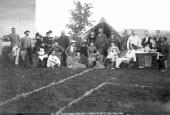
Shortly after their founding in the 1880s and 1890s, many Saskatchewan towns laid out clay tennis courts on vacant lots. These attracted both men and women players, who competed locally and regionally. In 1912, tennis enthusiasts organized the Saskatchewan Lawn Tennis Association, which from 1913 held provincial championships in men's and women's singles, doubles, and mixed doubles. Tennis was extremely popular in the 1920s. Regina, for example, had nineteen different clubs that competed regularly in leagues. The province's best player was Walter Martin, son of former premier W.M. Martin, who placed second in the national junior championships from 1925 to 1927, won three national intercollegiate championships, and was a member of Canada's international Davis Cup team from 1931 to 1934. The Depression of the 1930s and World War II reduced the number of players and competitions.
In the 1950s and 1960s, tennis changed because the largest clubs constructed courts with hard surfaces. Smaller clubs, both rural and urban, disbanded because they could not afford these improvements. Competitive tennis became centred at two urban clubs, the Riverside in Saskatoon, and the Civil Service, later renamed the Lakeshore, in Regina. In the 1970s tennis experienced a boom, with the number of players increasing dramatically. Hard-surfaced tennis courts were built at schools and in smaller communities; and competition at the Saskatchewan Summer Games, beginning in 1972, sparked new interest. Also, from 1974 until 1976 Saskatoon hosted a professional tournament that attracted the country's top players. Tennis became a year-round sport with the opening of indoor clubs in Regina in 1977 and Saskatoon in 1978.
In the 1980s and 1990s, the number of people playing tennis declined, but the sport also experienced successes. In the early 1980s, the Saskatoon club started a wheelchair tennis program, and in the 1990s it hosted three national tournaments. Four men have made major contributions to tennis in Saskatchewan. Dr. J.B. Kirkpatrick of the University of Saskatchewan organized clinics and tournaments for decades, and also recorded the history of the game. His colleague Dr. John Leiceister was both a top player and organizer. Bill Ebbels of Regina won seven provincial singles titles - more than any other player - and served often on provincial and club executives. Don Axtell, who arrived in Regina in 1968 after playing US intercollegiate tennis, raised the level of play by example, and helped organize the game at the club, provincial, and national levels.
Sandra Bingaman